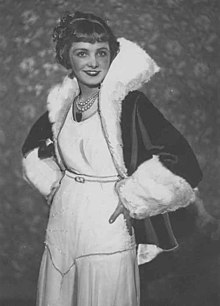| This article needs additional citations for verification. Please help improve this article by adding citations to reliable sources. Unsourced material may be challenged and removed. Find sources: "Stanisława Nowicka" – news · newspapers · books · scholar · JSTOR (March 2011) (Learn how and when to remove this message) |
Stanisława Nowicka (8 March 1905, in Warsaw – 24 October 1990, in York, New York) was a Polish dancer and singer, known as the "Queen of Tango".
Life
Nowicka studied in Grand Theatre, Warsaw, debuting as a dancer in 1915. In 1916 she and Pola Negri danced in "Casino" theatre in Łódź. She debuted as a singer in 1920, and in the same year performed as a singer together with Karol Hanusz.
In 1927 she started working in „Nowe Perskie Oko”, then "Morskie Oko", and then „Wesołe oko” cabaret. In 1929 she started recording songs for Syrena Rekord. The same year he gave Jerzy Petersburski's famous Tango Milonga (known in Europe as Oh Donna Clara) its debut in the Morskie Oko cabaret. Other songs she covered included tangos: „I tak mi ciebie żal”, „Nie odchodź ode mnie”, „Za dawno za dobrze się znamy”,and a popular song Chodź na Pragę for a revue Uśmiech Warszawy (1930). She performed as an actress and singer in Rycerze mroku (1932), her only film credit. Late 1934(?) or in 1936 the Polish daily Slowo Polskie sent her to New York as correspondent; she never returned. She ran a "Polish hour" in Radio Chicago, did some translation work and continued performing as a singer.
She was a spiritist and was considered a medium by many; she had a clairvoyance studio in Yorktown on Gomer Street, was active in the Theosophical Society in America. She used her medium skills by giving Aleksander Janta-Połczyński [pl] a diagnosis for his throat illness that supposedly came from "pre-World War One Greater Poland man" and by taking care of Jan Lechoń, who valued her spiritist prognoses and "Polish atmosphere" of her household.
She died in Yorktown in 1990, and has a symbolic grave on Bródno Cemetery in Warsaw.
References
- ^ Sołowianiuk, Paulina (2020-04-04). "Stanisława Nowicka. Aktorka, piosenkarka, medium". stare-kino.pl (in Polish). Retrieved 2023-05-03.
- Placzkiewicz, Jerzy (2006-01-06). "Tango in Poland, 1913 - 1939". Archived from the original on 2006-01-06. Retrieved 2023-06-26.
- ^ "Stanisława Nowicka krzewi humor lwowski w Chicago". Głos Poranny. 16 June 1935.
- "Southampton, L.I." Nowy Świat. No. 288. 16 October 1943.
- ^ Janta-Połczyński, Aleksander (1973). Nowe odkrycie Ameryki. Libella.
- "Ostatni weekend Lechonia". Życie Literackie. No. 21. 1982.
This article about a Polish singer is a stub. You can help Misplaced Pages by expanding it. |
This article about someone associated with the art of dance is a stub. You can help Misplaced Pages by expanding it. |
